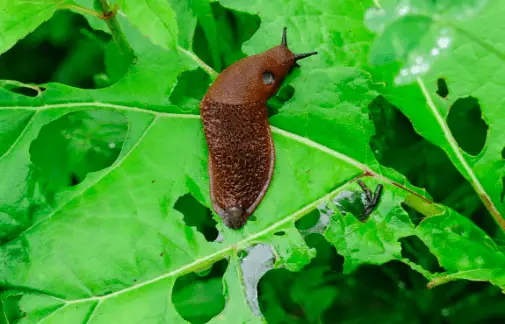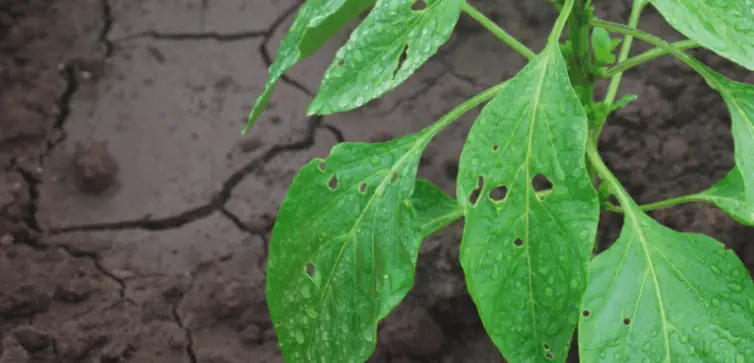Do you own a pepper plant? If you do, then you might have noticed small holes in the leaves. While alarming at first, it’s common to see holes in pepper plant leaves. There are a few reasons why this happens, and most of them are harmless.
In this blog post, I’ll be discussing the most common reasons for holes in pepper plant leaves. By the end, you’ll know how to deal with this issue if you ever encounter it. Let’s get started…
What Causes Holes in Pepper Plant Leaves?
Pests are the most common cause of holes in pepper plant leaves. The most common pests that cause this issue are slugs, beetles, cutworms, armyworms, hornworms, cabbage loopers, and aphids. All of these pests enjoy eating pepper plants, and any one of them can cause holes in the leaves.
Personally, I’ve found that slugs are the most common culprit. They’re often active at night, so you might not even see them. Slugs will leave a slime trail as they travel, so that’s another sign to look for.
How to Remove Pests from Pepper Plant?
Large pests, like slugs, can be removed by hand. Just go out at night with a flashlight and look for them. Once you find one, simply pluck it off the plant and dispose of them in a bucket of soapy water.
Sluggo (Amazon link) is a great product that you can use to control slugs. It’s an organic pellet that contains iron phosphate. The iron phosphate will kill the slugs, and it’s safe for plants, pets, and humans.

For smaller pests, like aphids, you can blast them off with a hose. Just aim the hose at the aphids and they’ll be gone in no time. While this will get rid of most pests, you may need to use a pesticide for stubborn ones.
My go-to solution to remove smaller pests is using Neem oil, which is an organic and natural pesticide. You can find this at your local gardening store. Simply mix it with water according to the package directions and spray it on your plants. It works by disrupting the life cycle of the pests, so they can’t reproduce. This will help to reduce the population over time.
You can also try using diatomaceous earth, which is a powder made from fossilized algae. It works by piercing the exoskeleton of pests, causing them to dehydrate and die. You can find this at your local gardening store as well.
Preventing Pests from Returning to Pepper Plant
The best way to keep your pepper plants hole-free is to prevent pests from returning in the first place. There are a number of ways to do this:
Quarantine new plants: Before adding new plants to your garden, make sure to quarantine them for at least a week. Any pests that they have will likely come out during this time. This will give you a chance to get rid of them before they have a chance to infest your other plants.
Keep your garden clean: Pests are attracted to gardens that are full of debris. Keep your garden clean by removing fallen leaves and dead plants. This will make it less inviting for pests.
Use row covers: Row covers are a great way to keep pests out of your plants. They’re made of a lightweight fabric that sits on top of the plants so that pests can’t get to them.
Beneficial insects: One of the best ways to control pests is by using beneficial insects. These are insects that eat other pests, so they help to keep the population under control. Ladybugs and green lacewings are two examples of beneficial insects.
What Else Could Cause Pepper Plant Holes?
There are a couple of other things that could cause holes in your pepper plant leaves.
Disease (Blight)
Blight is a type of plant disease that can cause holes in the leaves. The most common type of blight that affects pepper plants is called early blight. This disease is caused by a fungus that thrives in warm, humid conditions.
The first sign of this disease is small, dark spots on the leaves. These spots will eventually turn brown and the leaves will start to die. If you think your plants have blight, it’s important to remove any affected leaves as soon as possible. This will help to prevent the disease from spreading.
You can also try using a fungicide to treat blight. There are a number of products on the market that are specifically designed for this purpose.
Bad Weather
Holes in the leaves can also be caused by bad weather. Pepper plants are sensitive to cold temperatures and strong winds. If the temperature drops suddenly or there’s a severe storm, it can cause the leaves to develop holes.
If you live in an area that’s prone to bad weather, it’s important to take steps to protect your plants. You can do this by covering them with a tarp or sheet when the weather is bad. This will help to keep the leaves from being damaged.
Animals
It’s not just pests that can cause holes in your pepper plant leaves. Animals can also be responsible. If you have deer or rabbits in your area, they may try to eat your plants. This can cause damage to the leaves, resulting in holes.
You can try using a fence to keep animals out of your garden. Just make sure that the fence is tall enough to deter them. You can also try using repellents, but these need to be reapplied regularly.
Should I Prune Pepper Plant Leaves with Holes?
I only prune the leaves if I think a fungal disease is a cause. If the holes are caused by pests or bad weather, I don’t think there’s any need to prune the leaves. Pruning fungal leaves will help to prevent the disease from spreading.
If you do decide to prune your plants, make sure to sterilize your tools before using them. This will help to prevent the spread of disease. You can do this by dipping your tools in a solution of bleach and water.
Conclusion
Holes in your pepper plant leaves can be caused by a number of things, including pests, disease, bad weather, and animals, but pests are the most common cause. Take a closer look at your plants to see if you can identify the source of the problem. If you’re not sure, ask a professional for help.
Damage can prevent the pepper plant from growing and the peppers from turning red, so it’s important to take action if you notice any holes in the leaves.
I hope this article has helped you to figure out what’s causing holes in your pepper plant leaves. If you have any questions or comments, please feel free to leave them below. Thanks for reading!
Tim is an avid gardener from the UK. He was the founder of PlantCarer.com from 2021 to Sep 2023. He sold PlantCarer.com to Aaron. He has since started his own business called Seed To Supper, which provides new gardeners all the materials you need in a box (pots, seeds, compost and instructions) to grow your own delicious and nutritious vegetables and herbs from start to finish – no garden required.

